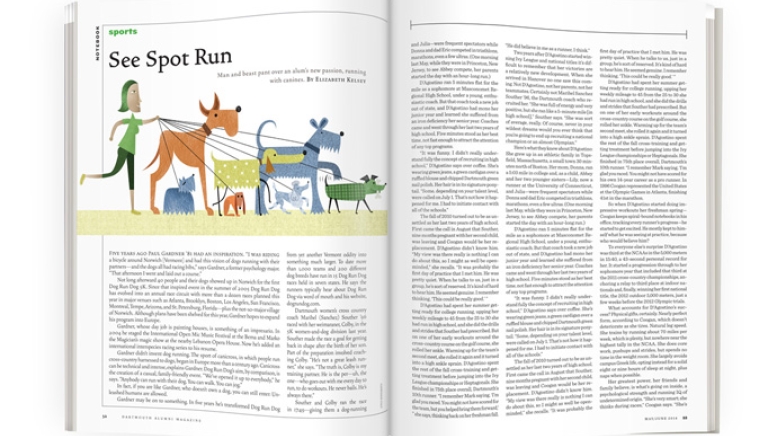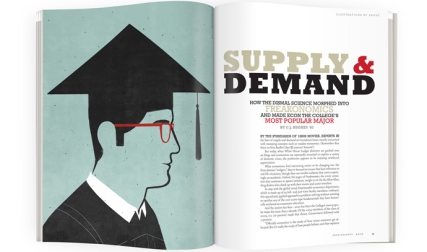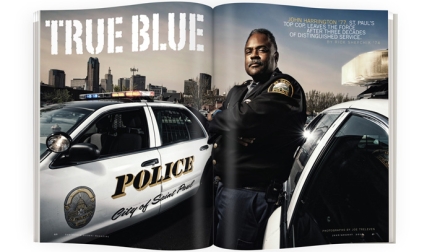Five years ago Paul Gardner ’81 had an inspiration. “I was riding a bicycle around Norwich [Vermont] and had this vision of dogs running with their partners—and the dogs all had racing bibs,” says Gardner, a former psychology major. “That afternoon I went and laid out a course.”
Not long afterward 40 people and their dogs showed up in Norwich for the first Dog Run Dog 5K. Since that inspired event in the summer of 2005 Dog Run Dog has evolved into an annual race circuit with more than a dozen races planned this year in major venues such as Atlanta, Brooklyn, Boston, Los Angeles, San Francisco, Montreal, Tempe, Arizona, and St. Petersburg, Florida—plus the not-so-major village of Norwich. Although plans have been shelved for this year, Gardner hopes to expand his program into Europe.
Gardner, whose day job is painting houses, is something of an impresario. In 2004 he staged the International Open Mic Music Festival at the Bema and Marko the Magician’s magic show at the nearby Lebanon Opera House. Now he’s added an international interspecies racing series to his resume.
Gardner didn’t invent dog running. The sport of canicross, in which people run cross-country harnessed to dogs, began in Europe more than a century ago. Canicross can be technical and intense, explains Gardner. Dog Run Dog’s aim, by comparison, is the creation of a casual, family-friendly event. “We’ve opened it up to everybody,” he says. “Anybody can run with their dog. You can walk. You can jog.”
In fact, if you are like Gardner, who doesn’t own a dog, you can still enter: Unleashed humans are allowed.
Gardner may be on to something. In five years he’s transformed Dog Run Dog from yet another Vermont oddity into something much larger. To date more than 1,000 teams and 200 different dog breeds have run in 15 Dog Run Dog races held in seven states. He says the runners typically hear about Dog Run Dog via word of mouth and his website, dogrundog.com.
Dartmouth women’s cross country coach Maribel (Sanchez) Souther ’96 raced with her weimaraner, Colby, in the 5K women-and-dog division last year. Souther made the race a goal for getting back in shape after the birth of her son. Part of the preparation involved coaching Colby. “He’s not a great leash runner,” she says. “The truth is, Colby is my training partner. He is the per—uh, the one—who goes out with me every day to run, to do workouts. He never bails. He’s always there.”
Souther and Colby ran the race in 17:49—giving them a dog-running world record. “It was a team effort,” she says. “Colby was literally pulling me.” Souther acknowledges she didn’t have much choice. “He can’t not pull,” she explains. “I had to spend the summer training him so he wouldn’t kill me.”
Dogs tend to run faster than their humans, and a strong runner benefits by as much as 30 seconds per mile, according to Ed Clifford of Raymond, New Hampshire, who last year bested his previous record in Norwich by three seconds with a time of 16:14. His Norwegian pointer, Maggie, is one of 15 dogs he trains to accompany him sledding, skiing, biking and running. “The dogs really want to do something. They’re bred for their intensity, and whatever they do they throw themselves into it 100 percent,” says Clifford.
Bob Norton Jr. of the Haddam (Connecticut) Volunteer Fire Co. and his dog Shadow, a Dalmatian, are another enthusiastic team. Shadow keeps fit by using the firehouse treadmill. But the duo nearly missed the 2009 Norwich race because of an emergency call. They arrived at the starting line just in time. “We run in local charity runs and I must say I’ve never experienced such a great group of runners—and Shadow couldn’t believe his eyes with all the dogs,” says Norton. “He got to rub noses with all types. We had great chats along the 10K route with a number of very dedicated animal lovers. Shadow had a great time. And when he has a great time, I have a great time.”
Dog Run Dog’s pre-race prep is more complicated than a typical road race. For example, water stops have buckets, and red pails are placed along the course for doggy-bag disposal. To avoid pit stops Gardner advises that people warm up their running mates before the race. “During these warm-up sessions the dog will most likely go,” he says.
Gardner’s main race-day worry is a massive dog fight. But to date that hasn’t happened. “The dogs seem to understand what’s going on,” he says. The biggest problem at Dog Run Dog races: Overly friendly dogs and owners who tangle leashes. “If you think of putting more than 100 dogs on a start line at one time, the interaction of the dogs is not something that is easily managed,” says Tom Kendall ’72 of Bart Race Services, a company that times the races.
Gardner and his team of volunteers hope to bring the sport into the mainstream by starting a national association to sanction events, create guidelines for the health and safety of dogs and dog runners, and develop ethics and training programs. Plans are afoot to launch an invitational dog-running world championship in 2012, but Gardner has an even loftier vision—the Olympics. “Dogs have been around us forever,” he says. “I think they deserve to get on the podiums at some point and win some gold medals.”
Elizabeth Kelsey is a contributing editor to Dartmouth Engineer magazine. In 2009 she placed second in the women’s solo division of the Norwich Dog Run Dog 10K.




